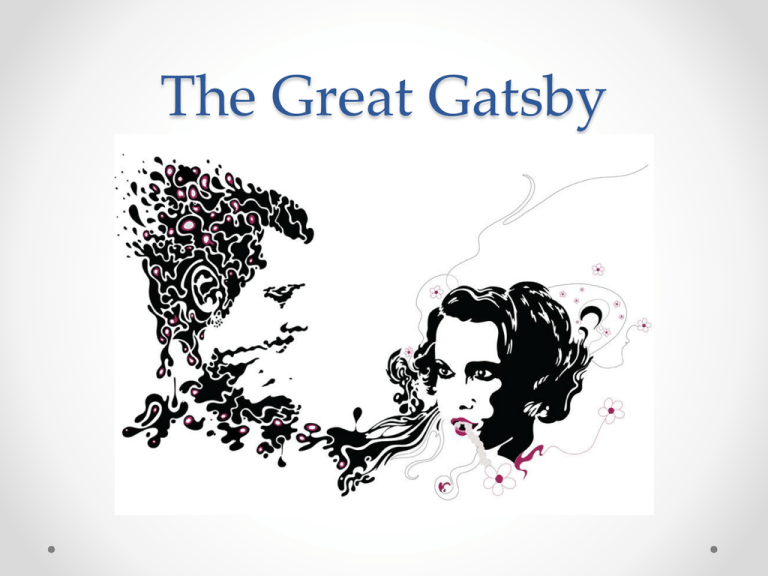The Great Gatsby
advertisement

The Great Gatsby Interpretation and Significance The Great Gatsby can be viewed in one of three ways: A veiled autobiographical account of Fitzgerald’s life A bitter criticism of the American Dream An allegory teaching the sinfulness of greed I. Autobiographical Novel “To Zelda, As Always” I. Autobiographical Novel A. B. C. D. Francis Scott Key Fitzgerald 1896-1940 Born in Minnesota, grew up in New Jersey Princeton dropout with immense literary talent Served in WWI military, but war ended before he could be deployed I. Autobiographical (cont.) E. Met Zelda Sayre while serving in military 1. 2. Zelda is rich, upper class southerner Zelda breaks off initial engagement when Fitzgerald can’t bring in enough money F. Publishes This Side of Paradise 1. 2. Immediate literary success. Zelda takes him back; they are wed I. Autobiographical (cont.) G. Socialite Ex-Patriots, they lived a lavish lifestyle and Fitzgerald was frequently broke. H. Tensions between Fitzgerald and Zelda increased 1. 2. 3. 4. She is schizophrenic, hospitalized at Hopkins He is an alcoholic, moves to Hollywood He drinks himself to death; dies of a heart attack after eating a candy bar She dies when her mental hospital catches on fire and she is locked in a room awaiting electroshock therapy Fitzgerald As Gatsby? Both men are haunted by women they could never make happy, women whose greed destroyed them. II.Criticism of American Dream “Gatsby had committed himself to the following of a grail.” II. American Dream A. Grail is an unattainable, elusive mythical object. B. Desire for the grail has driven countless men to ruin and death. C. Fitzgerald uses the search for the grail as a metaphor for the pursuit of the American dream. It is elusive, unattainable, and mythical. III. Moral Allegory A. Allegory: a story meant to convey a moral lesson (like a parable of sorts). B. The reader is meant to share in Nick’s “unaffected scorn” for the world he sees. C. God watches humanity, judges but does not intervene T. J. Eckleberg’s disapproving eyes, symbolic of God. IV. Symbolism • Great Gatsby is most commonly discussed in terms of its inventive use of symbolism. Key Symbols in the Text A. Eyes of T. J. Eckleburg 1. God’s judging, disapproving perspective on humanity. B. The Green Light 1. Longing and desire for those things which are most elusive. C. The Valley of Ashes 1. Empty, lifeless valley becomes a symbol for the empty, soulless people who traverse it. D. Gatsby’s Rolls Royce 1. How appropriate that a symbol of Gatsby’s wealth becomes an instrument of death. E. Pearl Necklace/Dog Collar 1. Tom gives Myrtle a dog collar as a gift, but a pearl necklace to Daisy. Myrtle is nothing but a pet to him; a plaything that he can mistreat. It emphasizes his greed; people are like possessions to him. Some Key Quotations in the Text • “Gatsby paid a high price for living too long with a single dream.“ • “So we beat on, boats against the current, borne back ceaselessly into the past.” • “I am one of the few honest people I have ever met.” • “[her voice] is full of money.” • “You see, I think everything’s terrible anyhow…I’ve been everywhere and seen everything and done everything…sophisticated, God, I’m sophisticated!” • “Can’t repeat the past? Why, of course you can!” • Gatsby “had committed himself to the following of a grail.” • “They’re a rotten crowd…you’re worth the whole damn bunch put together.” Gatsby And Its Relationship To Major Literary Periods • Age of Reason o Gatsby, like Ben Franklin, believed in self-improvement, but his failure is that he allows his imagination to control him. • Romanticism o Overindulgent imaginations of characters reveal dark side of humanity. • Realism o Grim reality is revealed, as is uselessness of Romanticism. All of the “dreams” of the characters are crushed, and they are left dead, sad, or alone.
